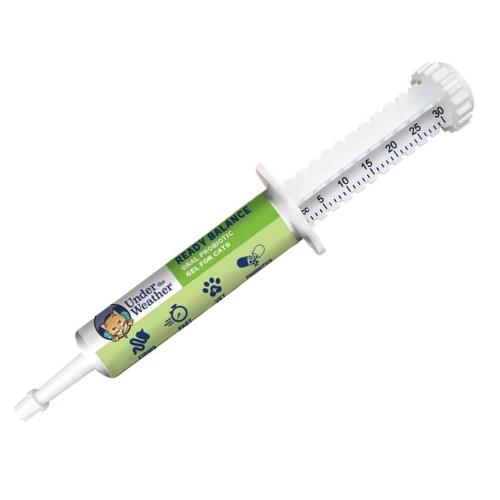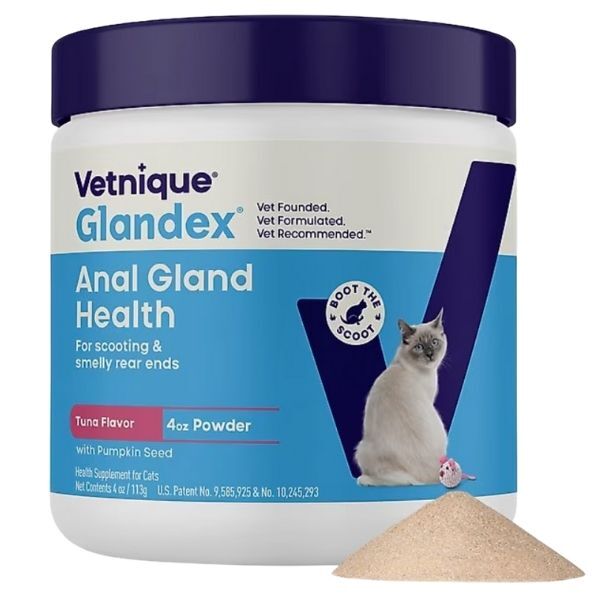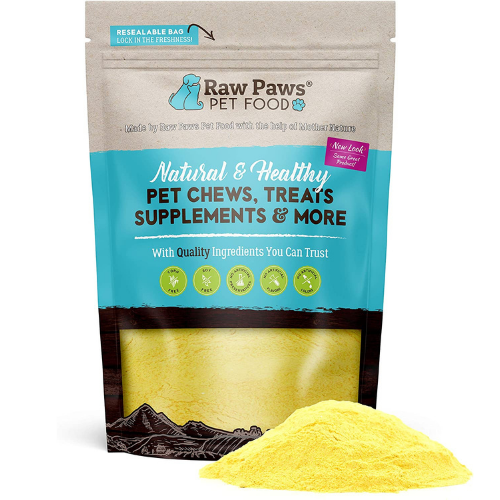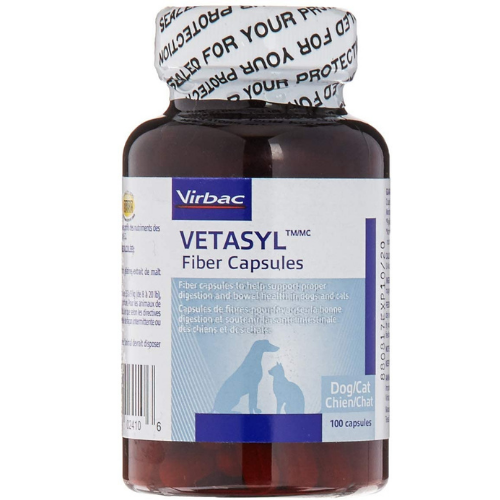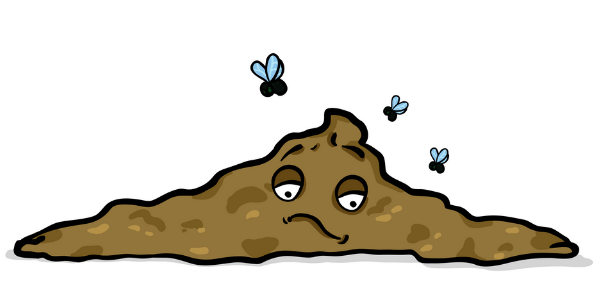
Just when you think nothing can be worse than waking up, and the moment you get out of bed, you step on a cold, slimy hairball... oh wait... the smell hits you.
It's not a hairball. Your poor kitty has diarrhea and didn’t make it to the litter box, or if they did, they painted the box with it.
Please tell me this wasn’t just my cats!
If you have a cat, you will likely have to deal with diarrhea at one time or another. And in some unfortunate cases, it may be a regular situation. If left unaddressed, it could lead to dehydration and nutrient deficiency.
What Is Diarrhea?
Diarrhea is the term used when your cat passes non-formed loose or watery stool more often and in larger amounts than they would normally defecate. It is a common condition that is a sign or symptom of other diseases or issues rather than a disease itself.
It can be the result of a minor condition, such as a stressor or diet change, that only requires simple treatment for its resolution, or it can be the result of a serious illness, such as cancer, that requires more involved treatments.
Diarrhea is one of the most common problems that bring cats into the vet. Even a mild case can become serious if not treated early enough.
Cats can become dehydrated and develop electrolyte imbalances. Therefore, knowing why your cat may have diarrhea and the possible cause helps you know when it is critical to seek medical care versus treating your cat at home.
If you've got a multi-cat home and aren't sure which of your cats is having diarrhea — try this colorful trick to ensure you're treating the right kitty.
Skip to Section:
When diarrhea is an emergency
How to treat cat diarrhea at home
Over-the-counter medications
Why cats get diarrhea
Be prepared to answer vet's questions
What your veterinarian might do
Helping an outdoor cat with diarrhea
How to Know When You Can Treat Diarrhea at Home
- Your cat is acting normally
- normal energy
- normal appetite
- No vomiting
- Your cat is up–to–date on their vaccines (such as feline panleukopenia)
- Your cat is a young adult (not very young or old)
- There are no pre-existing health issues such as Addison’s disease, kidney failure, cancer, etc.
How to Know When Diarrhea Is a Medical Emergency
- You suspect your cat has ingested a toxin or poison
- You suspect your cat has ingested a foreign body, such as a string or rubber band
- Your cat is low-energy and may seem weak
- Loss of appetite
- Vomiting (typically more than once or any time water and/or food is consumed). Always contact a veterinarian if any blood is noted, even if they vomit only once.
- Frequent bouts of diarrhea repeated over a couple of hours
- The diarrhea has lasted more than 24 to 36 hours despite home remedies
- There is a lot of blood (red) in the poop – small spots of blood are not necessarily an emergency
- The stool is black and /or tarry
- Your cat is continually straining to poop, and not much is coming out
- Your cat's gums are pale, bluish, whitish, yellowish, or gray in color
- Your cat's stomach is painful (rapid panting, groaning, or avoids being touched) and bloated
- Your cat is passing worms in their stool, or you see worms in their vomit
When in doubt, call your vet or an emergency hospital for advice.
For $5, you can connect to a veterinarian to discuss your cat’s diarrhea issue. Connect now
Rates may differ for those residing outside the U.S. You'll have access to a vet for 7 days.
How to Treat Your Cat's Diarrhea at Home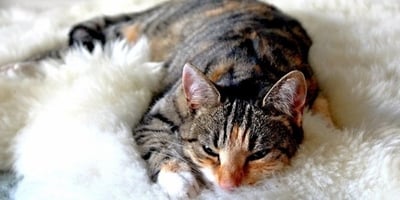
There are times when your cat may be off, and you can manage their diarrhea without a trip to the veterinarian.
If you have determined that it will likely be ok to try and “ride out” your cat’s diarrhea for 24 to 36 hours, then here are some options to help.
Rest
Just like with us, rest is important. Give your cat a quiet and comfortable place to recover. Ideally, placing them and a couple of extra litter boxes in a room with easy-to-clean floors will make life easier for those unfortunate poop accidents.
Hydration
It is critical that you maintain your cat’s hydration. During this period of time, you can give your cat rice water. The benefit of rice water over plain water is that it may help improve digestion, help alleviate gas and bloating, provide some beneficial minerals, and the carbohydrates provide some energy.
You want to use good-quality white rice (not minute rice). Brown rice is not recommended since it has too much fiber.
How to make rice water
Ingredients:
- 1 cup of White Rice
- 4 cups of Water
Instructions:
Boil 1 cup of white rice in 4 cups of water for 10 to 30 minutes (maybe longer) until the water turns a creamy white color. Remove the liquid and allow it to cool. Save the cooked rice for later use. Once cooled, give it to your cat as often as they will consume it.
Discontinue if your cat starts vomiting and contact your veterinarian. For those cats not interested, you can add a couple of teaspoons of pet-safe turkey broth (be sure it does not contain any onions or garlic).
Alternatives to rice water
If you find that rice water isn’t your cat’s thing, you can try clear, unflavored Pedialyte. Personally, I think the stuff tastes terrible and would prefer the rice water!
I do not recommend Gatorade because it is high in sugar, and that can cause further intestinal inflammation. There are electrolyte solutions made specifically for pets, as well.
No Need for Fasting
Cats need nutrition to heal their intestines. Therefore, cats are not fasted when they have diarrhea (unlike dogs, which often are). If they begin vomiting, however, you should withhold food and contact your veterinarian.
Bland Diet Options
1. Plain, boiled, boneless, skinless chicken and rice (the leftover from the rice water).
2. Chicken or turkey baby food (be sure it does not contain onions or garlic – the links we provided are pet-safe baby food choices)
Serving Size Example:
Offer a tablespoon or two every hour for a couple of hours. Then, allow them to rest for a couple of hours. If there are no vomiting or worsening symptoms, you can slightly increase the amount.
You will end up feeding smaller portions more frequently than what is their usual feeding routine.
3. There are prescription veterinary diets that work well as bland diet alternatives if cooking isn’t your thing! It is always helpful to regularly keep a couple of cans or a small bag at home.
For example, Royal Canin Digestive Care in dry or canned, Purina EN Gastroenteric food in dry or canned, Hill's i/d Digestive Care cat food in dry or canned.
How Long to Keep Your Cat on a Bland Diet
Generally, you will keep your cat on a bland diet for one or two weeks. During that time, continue feeding small amounts every 3 to 4 hours. If the diarrhea goes away, then over another one to two weeks, you will slowly transition them back to their regular cat food diet.
Do not give treats or any other food other than their regular cat food. Once they have been transitioned fully back to their regular cat food for a couple of weeks, then you can begin slowly offering extras such as their treats.
If you switch back to your cat's regular food too quickly, and don't leave enough time for healing and reduction of inflammation, you could end up right back where you started.
Questions? If you would like to speak with a veterinarian about your cat's diarrhea, Click here
Other Things That Can Help With Diarrhea
In addition to rest, fasting, and a bland diet, there are some other things you may find helpful in dealing with diarrhea issues at home.
Probiotics
Probiotics may be helpful when dealing with diarrhea. Since the digestive tract makes up about 60 to 80% of your pet’s immune system, keeping it healthy is important.
Probiotics help support a healthy immune system by keeping the intestinal bacteria in good balance and aiding in digestion.
You can try regular, unflavored, probiotic-rich yogurt (you want as low a sugar content as possible), or you can pick up a probiotic like Purina’s FortiFlora, Nutramax’s Proviable, VetriScience Fast Balance GI Paste, or VetriScience Probiotic Everyday.
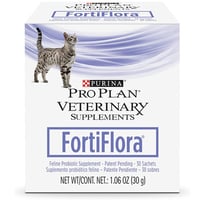
Note: If you want both prebiotics and probiotics for your cat, try FortiFlora SA. FortiFlora is good for everyday use.
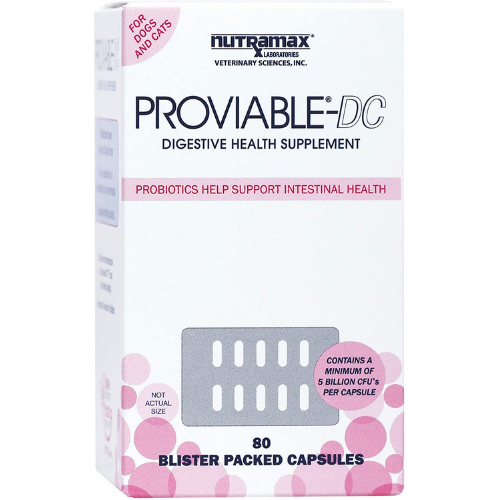
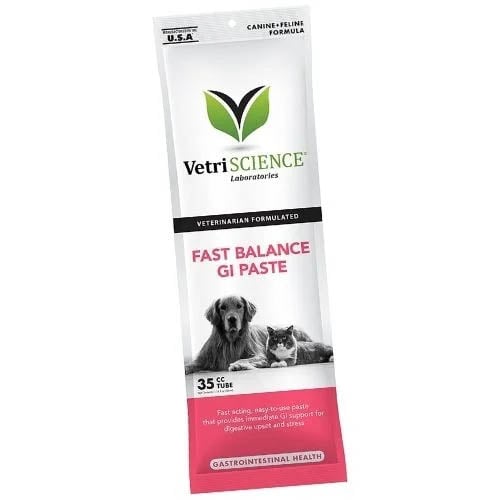
Fiber
Fiber, such as pumpkin, has been found to help with some cases of diarrhea. It acts as a prebiotic because it stimulates the growth of beneficial bacteria by lowering the pH and providing the nutrients they need. Additionally, it helps inhibit the harmful bacteria in the intestines.
Always be sure that your cat has access to plenty of fresh water when giving them fiber supplements. In the case of stress-induced diarrhea, starting a fiber supplement a few days prior to the stressful event can help prevent the diarrhea from starting.
Psyllium fiber can be purchased over the counter as whole husks in products like unsweetened, unflavored Metamucil. Serving: 1 – 4 teaspoons once to twice daily mixed in wet cat food. The effects can take 12 to 72 hours. You can also grind the psyllium fiber finer if you want to.
Warnings: While it is rare, some cats can have allergic reactions to psyllium. Signs of a reaction include itching or difficulty breathing. If you notice these symptoms, contact your veterinarian immediately.
Use extreme caution using this with diabetic cats. Its use can result in hypoglycemia.
NOTE: If your cat does not consume enough water while taking a fiber supplement, they are more likely to suffer with gas, and there is an increased chance of esophageal and gastrointestinal obstruction.
NOTE: Do not use any of the flavored varieties of Metamucil, especially those with chocolate. Additionally, read the labels to be sure they do not contain xylitol – it is very toxic to pets.
Promote Healing
Rebound Recuperation Formula for cats can also be very beneficial. While it isn’t a treatment for diarrhea, it acts as a support for recovery.
It helps promote hydration, which is important when cats have diarrhea. It contains prebiotics and antioxidants, which are essential in helping to support the immune system for recovery. It also helps stimulate them to eat and drink.
Over-the-Counter Medications and Why They Are Best to Avoid
You may be wondering why I have not mentioned over-the-counter (OTC) human medications, such as Kaopectate®, Pepto Bismol®, or Imodium®, for your cat.
The reason is that, depending on the cause of the diarrhea, these medications can do more harm than good. They should only be given if recommended by your cat’s veterinarian and only at the dose they advise.
These medications can be toxic to your cat, especially if dosed incorrectly. Pepto Bismol’s and Kaopectate’s active ingredient is bismuth subsalicylate. This ingredient is a derivative of salicylic acid or aspirin.
Cats are extremely sensitive to salicylates, and if your cat gets the wrong dose, toxicity can result. This can result in anemia, ulcers, and liver failure, regardless of the dose.
If your cat has intestinal bleeding that you are unaware of, bloody vomit and diarrhea, abdominal pain, and weakness may result. These medications may also affect platelet function, which can affect blood clotting times.
When blood does not clot, bleeding continues, which can lead to other issues. If given with any non-steroidal anti-inflammatory such as OnsiorTM, Metacam®, etc., there is an increased risk of intestinal ulcers or perforation. It can cause your cat’s stool to look blackish.
Blackish stool in cats is referred to as melena (digested blood in stool), which can indicate serious medical conditions. This can make diagnosing certain medical issues difficult and possibly add the need for more costly tests.
Lastly, the tablet form of the anti-inflammatory will appear radio-opaque (white) on X-rays. This may appear as a metallic foreign body and result in unnecessary surgery or other treatments.
Why You Should Use Extreme Caution With Imodium®
Imodium (which goes by the generic name Loperamide) is a synthetic opioid. All opioids are known to cause constipation. They work by slowing down gut motility, which allows for more fluid and salts to be drawn back into the body system.
It should only be given under the guidance of a veterinarian. The use in cats is extremely controversial and should only be used with extreme caution.
Imodium, when administered at safe levels, is not helpful for pain and, therefore, will not relieve any abdominal discomfort your cat may have.
In some cases, it can cause extreme excitement in some cats. Additionally, it can cause respiratory suppression in some cats.
You should never give Imodium to your cat if:
- If your cat has ingested a toxin or has an infection. The diarrhea is a way for their body to flush itself out and remove toxins and infections.
- If your cat has any medical conditions that can make them more susceptible to the negative side effects of the drug. Some health conditions are:
- Liver disease
- Kidney disease
- Hypothyroidism
- If your cat is vomiting, has abdominal pain (groaning, rapid panting, avoiding being touched, etc.), and is weak.
- If your cat is very young or old.
- If your cat is pregnant or nursing.
- If your cat has the MDR1 gene mutation
What If Home Treatment Doesn't Work?
When in doubt, when concerned, or when the diarrhea extends beyond a day or two, despite your best at-home efforts, your best bet is to have your cat — and their poo (try to get a sample with no litter!) — evaluated by your veterinarian.
No amount of internet searching and no number of trial-and-error home remedy attempts can compete with the comprehensive history taking, thorough physical examination, diagnostic testing, and the ability to prescribe safe and effective medications or supplements that only your veterinarian can offer.
Dehydration Is a Big Concern
Diarrhea causes dehydration because your cat is losing more fluids than they can take in. This lack of fluid balance prevents their bodies from functioning properly.
Diarrhea Can Cause Nutrient Deficiency
The small intestine is where cats absorb most of their nutrients from what they ingest. Therefore, when the cause of diarrhea relates to the small intestines, your cat is missing out on a lot of the nutrients they would normally gain from their food.
In addition to diarrhea, issues of the small intestines usually cause vomiting (increasing the risks of dehydration) and weight loss (because of the lack of nutrients).
For $5, you can connect to a veterinarian to discuss your cat’s diarrhea issue. Connect now
Rates may differ for those residing outside the U.S. You'll have access to a vet for 7 days.
Why Cats Get Diarrhea
There can be many causes of diarrhea in cats. Typically, cats will vomit or have diarrhea due to:
- Eating something toxic (plants, food, cleaning agents, human medications, etc.) or a foreign object (part of a toy, string, thread, paper, rubber bands, etc.)
- Too many table scraps or fatty foods can upset your cat's stomach
- Food allergy
- Rapid food change (switching between types or brands of food too quickly)
- Intussusception – this is a type of intestinal blockage where one part of the intestines telescopes into itself
- Inflammatory bowel disease
- Intestinal parasites
- Intestinal cancer
- Metabolic disease: kidney disease, pancreatitis, thyroid disease, diabetes, and others
- Viral, fungal, or bacterial infections
- Reaction to medications
When fecal matter moves through the intestines faster than normal, and there is decreased absorption of water, nutrients, and electrolytes, the result is diarrhea.
It is a symptom of diseases or other issues like toxins, foreign body ingestion, etc., that affect the small intestines, large intestines, or other organs outside the gastrointestinal tract.
Be Prepared to Answer Your Veterinarian's Questions
Being able to answer your vet's questions about your cat’s diet, environment, habits, behavior, and knowing the details about your cat’s diarrhea will aid in narrowing the list of possible causes.
Narrowing the list of possible causes also helps determine if and what specific tests are needed or if you will be able to treat the issue with some medications at home.
There are different characteristics for when diseases cause small intestinal diarrhea versus large intestinal diarrhea, and the diagnosis and treatment for both are generally different. Here are some details to pay attention to when you suspect your cat has diarrhea.
Characteristics of Small Intestinal Diarrhea:
- Large amounts of stool
- Mild increase in frequency (3 to 5 bowel movements per day)
- No straining or difficulty pooping
- Often accompanied by vomiting
- No mucus noted in the poop
- Cats often lose weight
- Excess gas may be noted
- Prominent gut sounds may be heard
- If blood is present, it is digested, and the stool will look black or tarry
Small intestinal diarrhea can be caused by any of the following:
- Feline panleukopenia
- Feline coronavirus
- Feline leukemia virus (FeLV)
- Feline immunodeficiency virus (FIV)
- Fungal infections
- Salmonella
- Clostridia
- Campylobacter
- Intestinal parasites
- Giardia
- Foreign bodies, such as paper, thread, string, etc., that get stuck in the intestines
- Bacterial overgrowth
- Inflammatory bowel disease
- Dietary indiscretion
- Sudden changes in diet
- Food allergies
- Toxins
- Intestinal tumors
Characteristics of Large Intestinal Diarrhea:
- Small amounts of stool
- Increased frequency of pooping – greater than 5 times per day
- Urgency to poop
- Straining is noted
- If blood is present, it is bright red
- Stool may contain mucus
- Normally, vomiting is absent, but 30% of cats will have vomiting
- Cats normally do not lose weight
Large Intestinal diarrhea can be caused by the following:
- Stress
- Viruses (FeLV and FIV)
- Whipworms
- Polyps
- Inflammatory bowel disease
- Cancer
- Ulcerative colitis
- Megacolon
As mentioned, there are organs outside the intestinal tract that can potentially cause diarrhea. Diseases that affect the kidneys, liver, and pancreas can all cause diarrhea.

What Your Veterinarian Is Likely to Do
History
Like any good investigation, thorough questioning is crucial to the process of determining the cause of your pet’s problems. It’s true for your cat’s diarrhea. It’s true for ANY problems your pet might be having. Typical historical questions your vet may ask when your cat is presented with diarrhea might include:
- How long has the diarrhea been going on?
- What does the stool look like — what color is it, is there any blood, etc.? (Here’s where it’s really nice if you’ve brought a fresh sample of it (without any litter if possible) – about 2 tablespoons, or at least a clear picture of it — I know, we’ve got the best job, don’t we!)
- Is your cat on any medications or supplements?
- What is your cat’s regular diet? This includes their cat food, treats (including human table food), and any other supplements. Take a photo of the bag and ingredient list if you can.
- Has your cat recently gotten into the trash or other places they shouldn't (like sewing or craft room, etc.)?
- Has your cat been around multiple other pets — including in your own home — and are those pets similarly affected?
The list truly goes on and on and gets refined and adapted depending on your answers. History taking is truly an art… and a very important one at that!
Physical Examination
Along with the history, the importance of a thorough physical examination truly cannot be understated. Your vet will evaluate and pick up on important things during the course of their physical examination.
These include whether or not your cat’s abdomen is painful or if there is abnormal fluid present within their abdomen.
Whether or not there is a mass or foreign body within your cat’s rectum or elsewhere within your cat’s digestive tract or other body systems. They can evaluate their anal sacs to determine if they are infected (yes, something that simple can cause bad diarrhea).
They’ll be able to evaluate if your cat is dehydrated or hypovolemic (low blood volume). There really is a wealth of important information that your vet will obtain from their physical examination of your cat.
Diagnostic Testing
Depending on what your vet is finding during the course of the history taking (this is why knowing the above characteristics about small intestinal diarrhea versus large is beneficial) and physical examination, they may well be recommending certain diagnostic tests to help “rule in” or “rule out” potential underlying causes.
Often, the first “go-to” test for investigating diarrhea in cats is a fecal float and smear — a test that looks primarily for intestinal parasites and abnormal intestinal bacteria.
There are also quick “benchside” tests to look for specific infectious organisms like Giardia, feline immunodeficiency virus, or feline leukemia virus.
Similarly, your vet might recommend blood testing to evaluate for the presence of diarrhea-causing conditions such as pancreatitis, small intestinal bacterial overgrowth, or others. Radiographs (x-rays), ultrasound, or other diagnostic imaging may also be necessary.
There are also times when an endoscopy to visualize the tissue is essential. This involves sliding a flexible tube with a light and camera into the upper or lower gastrointestinal tract. In some cases, biopsies of the tissue are taken during this procedure.
Lastly, surgery may be needed to take thicker biopsy samples from several different parts of the intestines to make a finalized diagnosis.
The tests your vet will recommend will be based on their initial impression or diagnosis for each of the potential underlying causes of your cat’s diarrhea.
Treatments
Some cats and some conditions require little to no treatment beyond a “bland diet” and “passage of time” to resolve the diarrhea. However, many cases, and most that go on for greater than 24–48 hours, need some treatment.
What’s best, what’s safe, and what’s likely to be most effective will best be determined by the results of the history, physical exam, and diagnostic testing.
Basic treatments often include intravenous fluids, medications to help stop the diarrhea (anti-diarrheal medications meant for cats), dewormers, medications to treat nausea, and possibly pain medications.
There are also times basic treatments involve dietary changes.
When the causes of diarrhea are more involved (food issues, disease, or cancer), more involved and specialized medications and treatments will be required. There are times a referral to a specialist may be recommended.
It is important to regularly monitor your cat's bathroom habits. This is the advantage of litter boxes!
- Are they going to the litter box more often than normal?
- Are they using places other than the litter box to poop?
- How long do they normally spend in the litter box?
- Are there any changes in the color of the poop?
- Are there any changes in the consistency or firmness of the poop?
Helping an Outdoor Cat With Diarrhea
If you have an outdoor cat, monitoring their bathroom habits can be a challenge. If you suspect your cat has diarrhea, staining of fur on the back of their legs and rump, weight loss, signs of dehydration, etc., you will need to try and isolate them in an area with a large litter box or two.
If your cat is used to pottying outside, you may have to use dirt instead of litter, and be sure they have plenty of privacy.
All of this information helps you know what is normal and abnormal for your cat. It will alert you to problems sooner, which may avoid a vet visit.
These key pieces of information – change in pooping habits, changes in poop color, firmness, amount, etc. – are very valuable when providing information to your cat’s veterinarian. It may save you a lot of time and possibly eliminate a lot of extra testing.




